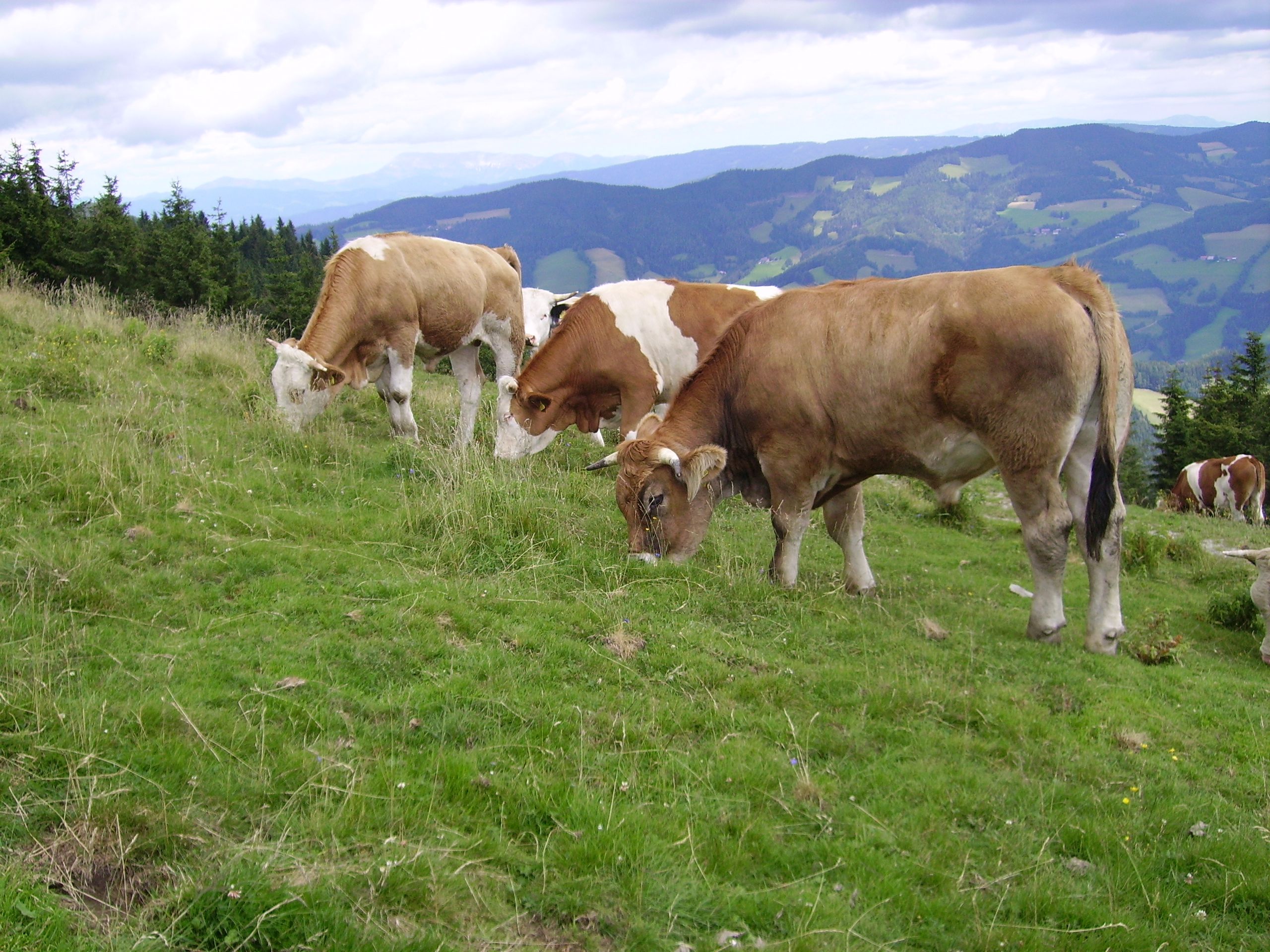Three extensive production processes with different ruminants were examined (sheep farming and lamb production, suckler cow farming and young cattle, ox fattening). All variants were evaluated with and without Alpung. Existing results from organic milk production were used as basic reference data, as it is the most intensive form of ruminant farming in extensive agriculture. A comparison with intensive livestock farming or arable farming was not carried out because these forms of farming cannot be implemented in mountain areas.
The alpine pasture period itself is largely uncontaminated by direct and indirect releases, and even the greenhouse gas pollution can be viewed as neutral in the long term. In all cases, alpine farming has a lower environmental impact. The largest influence on the results is the purchase of animals in specialized ox fattening and the lower production efficiency in lamb production. Suckler cow farming performs favorably.
Overall, the animals' earnings during the alpine pasture season are offset by virtually no emissions. Extensive use of alpine pastures is the best contribution to sustainability in keeping ruminants. Nevertheless, it is the art of agricultural management to organize the optimal use of resources for one's own location.
Influence of alpine pasture management on the environmental impact per hectare
|
Environmental impacts per ha (land management) |
|||||||
|
Environmental impact |
Unit |
Value |
Normalization |
||||
|
Extensive cattle farming |
dairy cattle |
Extensive cattle farming |
dairy cattle |
||||
|
with Alm |
without alpine pasture |
with Alm |
without alpine pasture |
||||
|
Non-renewable energy |
MJ |
10.474 |
15.239 |
19.623 |
0,5 |
0,8 |
1 |
|
Global warming potential GWP 100 |
kg CO 2 e |
3.921 |
5.591 |
7.323 |
0,5 |
0,8 |
1 |
|
Potential nitrogen losses |
kg N |
13,73 |
17,66 |
19,54 |
0,7 |
0,9 |
1 |
|
Potential phosphorus losses |
kg P |
0,42 |
0,54 |
0,56 |
0,7 |
1,0 |
1 |
|
Heavy metals in the soil |
kg 1.4-DBe |
1,32 |
1,60 |
1,34 |
1,0 |
1,2 |
1 |
Influence of alpine pasture management on the environmental impact per 100 MJ VE
|
Environmental impacts per 100 MJ PU (nutritional mandate) |
|||||||
|
Environmental impact |
Unit |
Value |
Normalization |
||||
|
Extensive cattle farming |
dairy cattle |
Extensive cattle farming |
dairy cattle |
||||
|
with Alm |
without alpine pasture |
with Alm |
without alpine pasture |
||||
|
Non-renewable energy |
MJ |
730 |
868 |
190 |
3,8 |
4,6 |
1 |
|
Global warming potential GWP 100 |
kg CO 2 e |
271 |
312 |
71 |
3,8 |
4,4 |
1 |
|
Potential nitrogen losses |
kg N |
0,96 |
1,02 |
0,17 |
5,5 |
5,8 |
1 |
|
Potential phosphorus losses |
kg P |
0,028 |
0,030 |
0,006 |
4,9 |
5,3 |
1 |
|
Heavy metals in the soil |
kg 1.4-DBe |
0,094 |
0,099 |
0,014 |
6,9 |
7,3 |
1 |
Influence of alpine pasture management on the environmental impact per kg of protein
|
Environmental impact per kg of dietary protein (nutritional mandate) |
|||||||
|
Environmental impact |
Unit |
Value |
Normalization |
||||
|
Extensive cattle farming |
dairy cattle |
Extensive cattle farming |
dairy cattle |
||||
|
with Alm |
without alpine pasture |
with Alm |
without alpine pasture |
||||
|
Non-renewable energy |
MJ |
316 |
376 |
119 |
2,7 |
3,2 |
1 |
|
Global warming potential GWP 100 |
kg CO 2 e |
117 |
135 |
44 |
2,7 |
3,1 |
1 |
|
Potential nitrogen losses |
kg N |
0,42 |
0,44 |
0,11 |
3,8 |
4,0 |
1 |
|
Potential phosphorus losses |
kg P |
0,012 |
0,013 |
0,004 |
3,4 |
3,7 |
1 |
|
Heavy metals in the soil |
kg 1.4-DBe |
0,041 |
0,043 |
0,009 |
4,8 |
5,0 |
1 |






